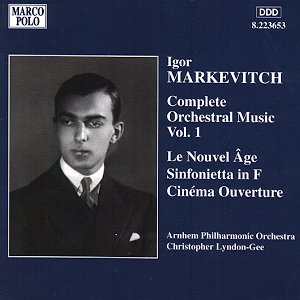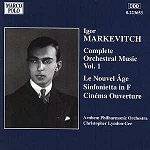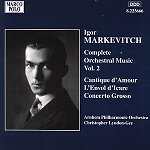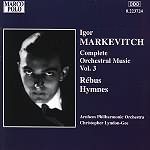
| Vol. 1
Le Nouvel Age (1937)
Sinfonietta in F (1929)
Cinéma-Ouverture (1931)
Arnhem PO/Christopher Lyndon-Gee
MARCO POLO 8.223653 [54.31] |
Vol. 2
Cantique d'Amour (1936)
L'Envol d'Icare (1932)
Concerto Grosso ((1930)
Arnhem PO/Christopher Lyndon-Gee
MARCO POLO 8.223666 [54.51] |
Vol. 3
Rébus (1931)
Hymnes (1932-1936)
Arnhem PO/Christopher Lyndon-Gee
MARCO POLO 8.223724 [54.30] |
INTRODUCTION
Markevitch's fame rests, these days, on his reputation as a conductor. In
this context his complete Tchaikovsky symphony cycle (including
Manfred) though which I came to these symphonies is the most notable.
It has been reissued on CD but I first came to know it through the mountainous
Philips/Fontana boxed LP set which a friend bought in a sale in W H Smiths
in Torquay in 1970.
Like Furtwängler, Klemperer, Goossens, Paray and many others Markevitch
had difficulty in getting his music accepted by concert promoters and the
music establishment. It is only now that the music is gaining some exposure
and this set is of great significance in the rehabilitation of this Russian
composer's music.
Markevitch was born in Kiev and with his family moved to Paris in 1914. At
the age of 13 he played his piano suite Noces to Cortot who then became
the child's teacher. In 1929 he made his real breakthrough when he played
his Sinfonietta to Diaghilev who promptly took up the 17 year old
boy wonder. By the age of twenty he was well on the way to world-wide success
as a composer. Rubbing shoulders with Nijinsky, Cocteau and (at first) Stravinsky
(who later reviled him) he made a great éclat in Paris. His music
was feted by the avant-garde but this aspect of his life halted mid-stride
in 1941 when he put composition behind him and gave himself completely to
conducting; A decision taken at the age of 29! His music therefore is the
music of a young man.
Vol. 1
 Le
Nouvel Age: This is a three movement work. The Ouverture reeks
of Mossolov's machine music and Antheil's propellers. The second movement
Adagio is eerily quiescent ruffled by the occasional trumpet call.
The final Hymne is a dance to exhaustion. The brass heave and shout
and there is some robotic passion too of the type you might associate with
the mechanical seductress from Lang's film Metropolis. This gathers
itself in the last pages into a simulacrum of Satie's Relache and
Parade. The work was premiered by the Warsaw PO in January 1938.
Le
Nouvel Age: This is a three movement work. The Ouverture reeks
of Mossolov's machine music and Antheil's propellers. The second movement
Adagio is eerily quiescent ruffled by the occasional trumpet call.
The final Hymne is a dance to exhaustion. The brass heave and shout
and there is some robotic passion too of the type you might associate with
the mechanical seductress from Lang's film Metropolis. This gathers
itself in the last pages into a simulacrum of Satie's Relache and
Parade. The work was premiered by the Warsaw PO in January 1938.
The Sinfonietta: 27 December 1928 was a momentous date in Markevitch's
chronology. That night he attended a performance of Petrushka during
the last season of Diaghilev's Ballets Russes. In the interval he was introduced
to Diaghilev, Nijinsky, Karsavina, Lifar and Benois. Diaghilev, having heard
the Sinfonietta, played through by the composer at the piano
by Markevitch was deeply impressed.
The Sinfonietta is in four movements. The first is busy, perky, jerky
and neon-bright in Stravinsky garb. The Allegretto is a leaf from
the book of the Symphonies of Wind Instruments. The following andante
is tentative in style with a meandering trumpet solo and deliberate Dies
Irae variant. The allegro risoluto has the darting energy of a
metallic hummingbird and the sheer impact of the Rite of Spring in
its thunderous closing measures.
The Cinema Ouverture. This is a feral collage with tension, cimbalom
noises, bells, klaxons, buzzers, whistles, gruff barking brass and drum rolls.
Vol. 2
 Cantique
D'Amour is a world premiere recording. Its warm coaxing strings and
high-pitched woodwind contribute a warmly enveloping atmosphere almost
paralleling Daphnis - a rare departure for Markevitch who could rarely
summon tenderness in his own music. He cannot resist the mechanistic uproar.
It asserts itself in the middle section of the Cantique. Markevitch's
music is never far from cataclysm and here that dominance wrests control
from the tender emotions which return for the final section.
Cantique
D'Amour is a world premiere recording. Its warm coaxing strings and
high-pitched woodwind contribute a warmly enveloping atmosphere almost
paralleling Daphnis - a rare departure for Markevitch who could rarely
summon tenderness in his own music. He cannot resist the mechanistic uproar.
It asserts itself in the middle section of the Cantique. Markevitch's
music is never far from cataclysm and here that dominance wrests control
from the tender emotions which return for the final section.
L'Envol d'Icare traces the story of Icarus and his doomed flight.
Vibraphone, tom-toms, strange squeaks and woodwind whistles, mysterious warbling
and tramping marches wind and blast through this score. Gargoyle-shouting
brass contrast with sphinx-like percussion and assault the listener in full
flight and clamour. Icarus's flight is delivered in train rhythms suggesting
a mechanical wing-beat. Forty-five seconds of long-held pregnant tension
foretells the fall and this is succeeded by the insistently quiet music of
La Mort d'Icare.
The Concerto Grosso is another world premiere recording. Busy and
criss-crossing jittery themes, snarling and barking brass shape the first
movement in music that cannot claim to be tender or very human. It is however
impressive and will be enjoyed by all those who warm to Pulcinella.
A cool andante alternates Shostakovichian intensity (2.44) with
deep-freeze versions of De Falla in what I can only call arctic Latino music.
The final whispery pizzicato soon bolts into knockabout Shostakovich - like
something from Shostakovich 9 or the second and third movements of No. 6.
Vol. 3
 Rébus
(1931) is Markevitch's reflection on Death. It is in six movements. The
Prelude's pecking trumpets provide the clean and sharply-defined jerky
motion of some meccano insect. The Danse is alive with hectic and
heartless stamping energy. Reference points are Prokofiev's Scythian Suite
and Stravinsky's Pulcinella. The music is brassily dominant; not
at all romantic. Motor horn evocations are clear to hear in the Gigue
and the Variations include the cool rivulet flow of the flute.
More locomotive speed impacts in the Fugue with a dash of howling
desperation (2,03). The Parade's woodpecker chipping (Markevitch is
strong on staccato and weak on legato) soon tips over the edge into hysteria
and the edge of the chasm; back to a nightmare vision with salvos and volleys
of car horns.
Rébus
(1931) is Markevitch's reflection on Death. It is in six movements. The
Prelude's pecking trumpets provide the clean and sharply-defined jerky
motion of some meccano insect. The Danse is alive with hectic and
heartless stamping energy. Reference points are Prokofiev's Scythian Suite
and Stravinsky's Pulcinella. The music is brassily dominant; not
at all romantic. Motor horn evocations are clear to hear in the Gigue
and the Variations include the cool rivulet flow of the flute.
More locomotive speed impacts in the Fugue with a dash of howling
desperation (2,03). The Parade's woodpecker chipping (Markevitch is
strong on staccato and weak on legato) soon tips over the edge into hysteria
and the edge of the chasm; back to a nightmare vision with salvos and volleys
of car horns.
The Hymnes' Prelude occupies the foreground with a steady pace:
contented but with undercurrents disquiet and of the screw of tension being
slowly turned tighter and tighter. The Hymn of Work is undeniably
exciting at a visceral level and is once again from a similar source as
Mossolov's Music of Machines and Honegger's Pacific 231. The
other Hymns have cartwheeling flutes, desperate work for the brass and a
sense of paranoia which finally relaxes into the Hymne à la Mort
in which the music floats, forms and reforms like a film of petrol on
the surface of the water accompanying a Bach-like chorale. However the foremost
mood here is one of disquieting fogs and souls cut loose in a wasteland of
the senses.
CONCLUSIONS
All three volumes have English-only notes: very extensive and detailed they
are too. There is full background on each work and a detailed chronology
which is extremely helpful in placing the music in historical and artistic
context. The conductor contributed the notes and must, on this evidence,
be the voice on Markevitch's music. I for one hope to hear Markevitch's
major choral/orchestral pieces in Lyndon-Gee's interpretations. A recommended
set providing a most distinguished contribution to the history of music in
the twentieth century.
Reviewer
Rob Barnett

PS: I can think of few teams better fitted to tackle the Lev Knipper symphonies
and the choral and orchestral works of Maximilian Steinberg than Marco Polo,
Lyndon-Gee and the Arnhem orchestra.

